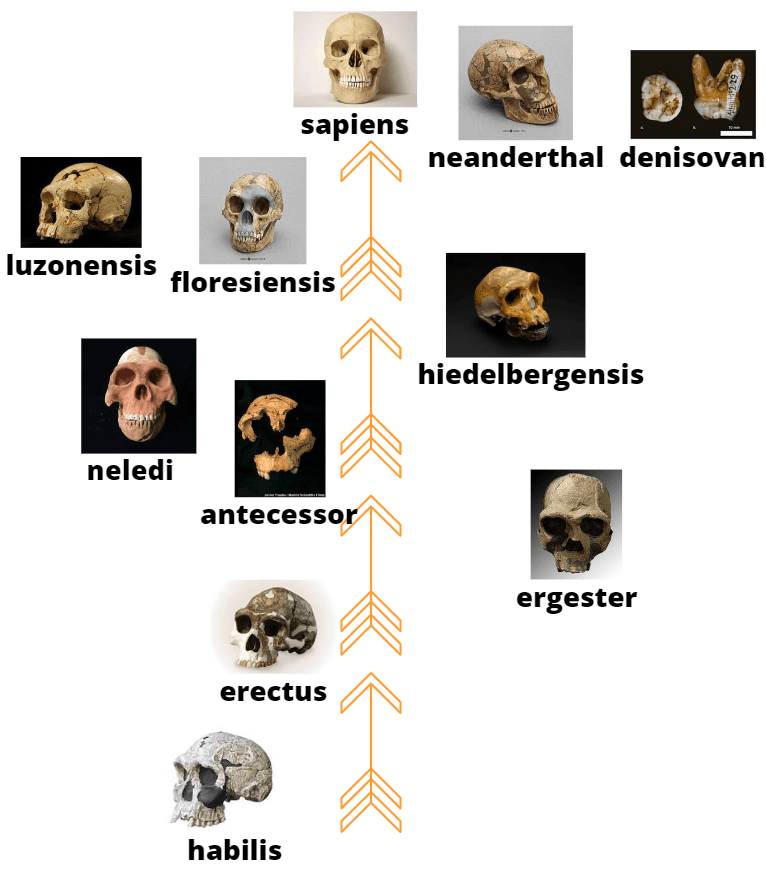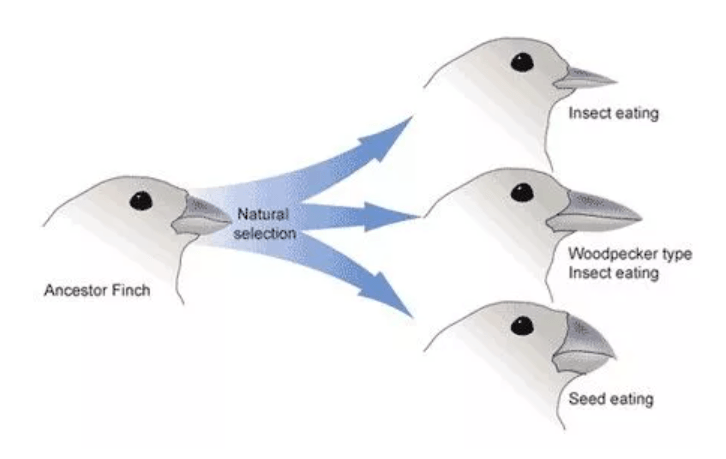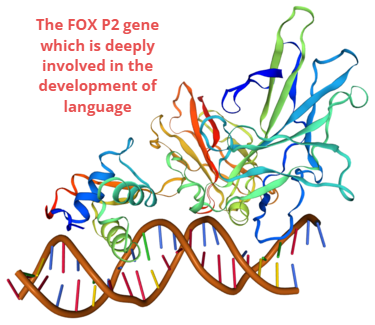The Human Family
Human History stretches back 2 million years. Humans originated in Africa but there is evidence of them existing outside of that continent from as early as 1.8 million years ago (Dmanisi, Georgia). Yet these humans were not us. Whilst Homo Sapiens might be the only representatives of the human (Hominin) family existing to day, they did not exist as a species when the first humans walked out of Africa.
The human fossil record (in some cases represented by very few samples) reveals at we have multiple, now extinct, human relatives. Working backwards from modern times In rough date order these are:
- Neanderthal (Europe/ Asia): 400 - 40 thousand years ago.
- Florensis / Luzonensis (Far East Asia): 120(?) - 50 thousand years ago.
- Naledi (Africa): 340 - 235 thousand years ago.
- Denisovan (Asia): 500 - 20 thousand years ago.
- Hiedelbergensis (Europe/ Middle East - possibly not a distinct species): 1.5 million years.
- Antecessor (Europe/ Asia): 1.3 - 0.8 million years ago.
- Ergaster (Africa - possibly same species as Erectus ): 1.7 - 1.4 million years ago.
- Erectus (Asia/ Europe/ Africa): 2 million years - 120 thousand years ago.
- Habilis (Africa) 2.3 - 1.6 million years ago.
There are most certainly others, the evidence of which maybe be found as fossils, lying around in the dirt somewhere undiscovered, or in the genetic sequences, of current human populations, where evidence of these 'Ghost' species can be found in genetic sequences which did not originate in Sapiens but must have come species for which there is no fossil evidence. Denisovans are an example of a 'near-Ghost' species for which there is little fossil evidence (a couple of teeth and a few scraps of bone, but are represented in DNA sequences found in large sections of Sapiens populations that exist in Asia, today (up to 4% of the genome).
Species
To answer a question such as 'was a Neanderthal the same species as a Sapiens?', we need to consider what is meant by the word 'species'. Geographic isolation would have exposed the different populations to different environmental pressures. This would cause changes in chromosomes of the local population so creating divergence between different groups, each developing their own distinctive characteristics. This raises the question, 'at what point does the accumulation of these distinctive characteristics, reach such a level that speciation occurs? A review of literature on this topic reveals 34 different definitions of what constitutes a species.
The article below from National Geographic, references a definition that references the ability to breed and produce viable, fertile off-spring, but then considers the development of hybrids such as the Polar Bear/ Grizzy bear cross. The same arguments apply to us Sapiens. In Europe and Asia, Sapiens contain between 2-4% Neanderthal DNA, implying that early Sapiens populations bred with Neanderthals. The DNA of African populations also reveal interbreeding with non-Sapiens Humans although not Neanderthals. We are hybrids.
This site will adopt the conventional approach of classifying species principally on the basis of morphology of the skeleton. But always remembering that when you have a very small sample size (as is the case in Palaeo Anthropology) variations might be over interpreted.


Species: (from National Geographic)
From the colour of your hair to the shape of your toes, you are distinctly human. Humans look very different from one another, yet we are all members of the same species, homo sapiens. A species is often defined as a group of organisms that can reproduce naturally with one another and create fertile offspring. While that definition seems straightforward, the classification of a species can be difficult and at times riddled with controversy.
Some organisms easily fit into this definition of a species, but many do not. Asexual organisms have only one parent, so they do not reproduce with each other. Some organisms commonly reproduce with similar species in the wild, forming genetic hybrids. In 2006, the first wild polar bear–grizzly bear hybrid was found in Canada. Called “pizzly” or “grolar” bears, these hybrid bears can produce fertile offspring. However, polar bears and grizzly bears are still classified as different species due to their habitat needs.
These naturally occurring wild rule breakers make it difficult for scientists to clearly define species. Genetics may provide the answer. Through genetic analysis, scientists can now classify species through patterns in DNA. This technology has uncovered new relationships between species—and a few unexpected surprises. A recent genetic analysis revealed that giraffes—long thought to be one species—are actually four distinct species. Discoveries such as this could lead to conservation concerns, should scientists discover a new endangered species “hiding” in a larger population of similar organisms.
D.N.A.
D.N.A. stands for deoxyribonucleic acid, an organic, complex molecule that is found in all life. The way the molecule is configured is referred to as it DNA code and this contains the genetic information that defines the lifeform in which it is found. The function that DNA performs is to manufacture proteins , the building blocks of life. The current, modern human genome is capable of encoding approximately 19,000 different proteins.
By being able to reproduce itself, the DNA molecule is responsible for inheritance and therefore allows the establishment of a species. The recognition of ancient genetic sequences in modern populations is a relatively modern technique that is being used to identify human ancestor species and map human migration journeys. DNA comes in two types. The type that most people are referring to when discussing genetics, is nuclear DNA where half of the genetic code comes from the father and half from the mother. The, second type is called mitochondrial DNA (mtDNA), unlike nuclear DNA it passes intact from the mother, there is no input from the father. Whilst nuclear DNA is responsible for morphology (how you look and what you are made of), mtDNA is used to regulate your metabolism (how your body powers itself.
Beside from only being passed down the maternal line, mtDNA has other features that distinguish it from its nuclear cousin. These include the fact that it has a far higher mutation rate (about 100 greater than nuclear) and contains far fewer genetic codes (less than 17,000 base pairs compared with the 3.3 billion that exist on nuclear).
Ancient D.N.A.
It was in the late 1990s that researchers became interested in the possibilities offered by genetics to the study of Palaeoanthropology. It was through the work pioneered by Savante Paabo that techniques were developed to extract ancient DNA. Savante was awarded a Nobel prize for his work in 2022.
It is now understood that DNA can survive in bones and teeth for extraordinary lengths of time given the right environmental conditions. The oldest ancient DNA extracted to date (Feb 2021)was found when scientists sequenced the DNA from a mammoth that had been buried in Eastern Siberian permafrost over 1 million years ago.
DNA survives less well in bones from temperate environments, but cave environments seem to provide some protection. The oldest ancient, human DNA that has been successfully extracted and analysed, is from the tooth of an archaic human species (probably Hiedelbergensis/ Antecessor) from Atapuerca in Spain. This was dated at 800,000 years ago. The oldest Homo Sapiens DNA found so far is from a 45,000 year-old remains found in the Balkans.
